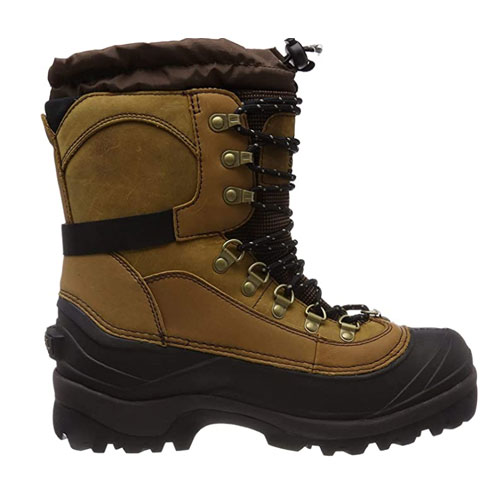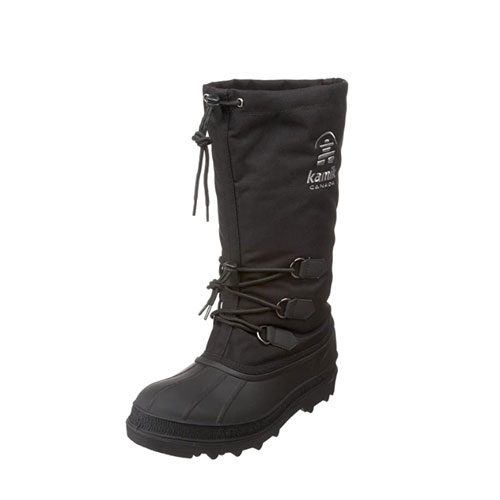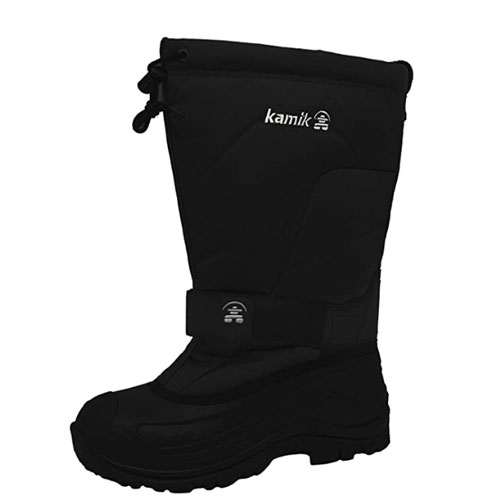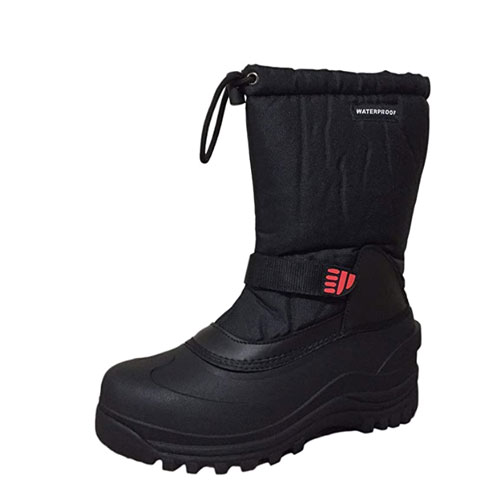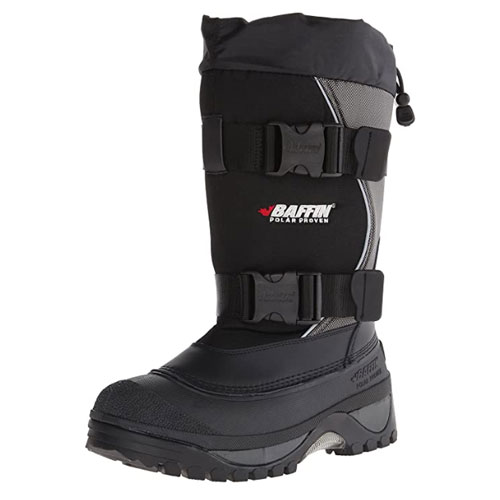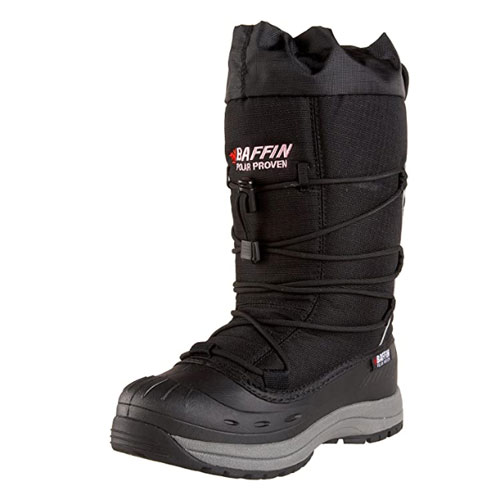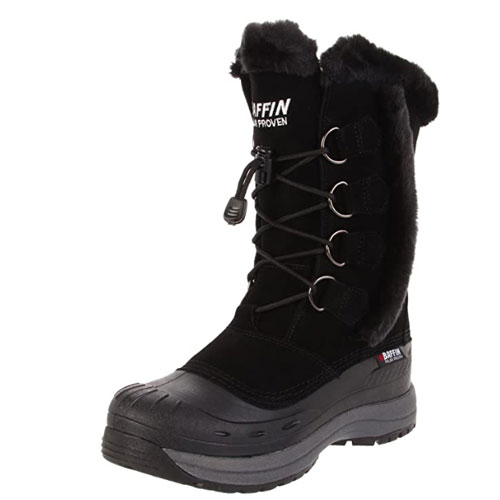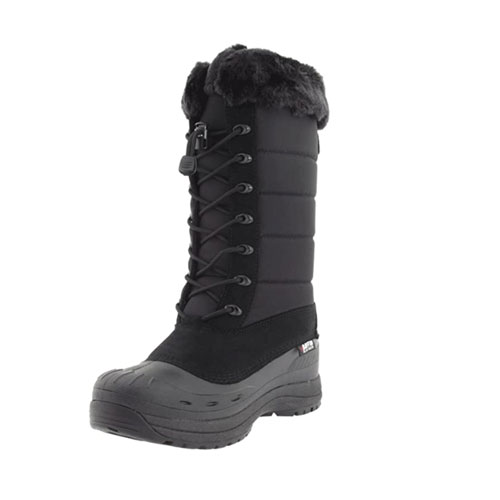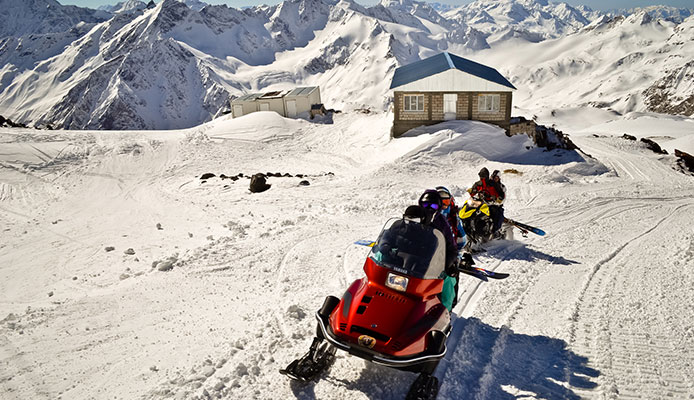
When you set out for a snowmobiling adventure, you want to make sure all of your equipment is reliable and up to the task. Once you have chosen the snowmobile that is for you, you should focus on finding accessories that are tough, durable, well constructed and ready for anything you might throw at it. Investing in the best snowmobile boots you can find is, therefore, an essential step towards a safe and enjoyable experience.
Finding the best snowmobile boots for the job can be a daunting task, but they are crucial to ensuring the well-being and integrity of your feet, a part of your body that, if not taken care of, can quickly turn your exciting day into a nightmare. Think of how even something as simple as hitting your small toe can make you feel for the rest of the day!
Like every other piece of equipment, the options seem endless and intricate, but here we have compiled a list of the eight best snowmobiling boots of 2023 to help you sort through the mess and identify which ones best suit your needs.
OUR TOP PICK
Sorel Conquest Men’s
- Stand Out Features - Why We Love It
- Built with waterproof leather
- Seam sealing
- Heel height is 4 inches
- 400 grams of insulation
Upper material: Waterproof grain leather and synthetic textile
Temperature rating: -40°C/-40°F
Sole: Rubber
Ankle support: Yes
EDITORS CHOICE
Kamik Canuck Cold Men’s
- Stand Out Features - Why We Love It
- Knee-high protection
- Rubber shell around foot
- Adjustable snow collar with lace lock
- Good traction
Upper material: 1000 Denier waterproof nylon
Temperature rating: -40°C/-40°F
Sole: Rubber
Ankle support: No
BEST VALUE
Kamik Greenbay 4 Men’s
- Stand Out Features - Why We Love It
- Mid foot adjustable Velcro strap
- Synthetic RubberHe sole
- Excellent price/quality ratio
- Removable thermal guard liner
Upper material: 600 Denier nylon
Temperature rating: -40°F/-40°C
Sole: Rubber
Weight per pair: 3.8s lbs
Climate X Ysc5 Men’s
- Stand Out Features - Why We Love It
- Removable inner liner
- Thermolite insulated
- Pull on model
- Less expensive than other models
Upper material: Water repellent nylon
Shaft height: 11 inches
Sole: Rubber
Weight per pair: around 3 lbs
Baffin Wolf Men’s
- Stand Out Features - Why We Love It
- Double buckle straps
- Proprietary EVA midsole
- Removable insulated inner boot
- Made of leather and textile
Upper material: leather and 900 denier nylon
Temperature rating: -40°C/-40°F
Sole: Rubber
Ankle support: Yes
- Stand Out Features - Why We Love It
- Uses PolarProven technology by Baffin
- 100% Synthetic
- Inner boot prevents moisture
- Lightweight
Upper material: Leather and 900 denier nylon
Temperature rating: -40°F/-40°C
Sole: Recyclable rubber
Weight per boot: 1 lb 6 oz (size 6)
- Stand Out Features - Why We Love It
- Unique look with faux fur trim
- Traction outsole
- Removable inner layer
- Excellent insulation
Upper material: leather and 900 denier nylon
Temperature rating: -40°C/-40°F
Sole: Rubber
Shaft height: 10 inches from arch
- Stand Out Features - Why We Love It
- Stylish design
- Rated to -40 degrees
- Composite sole for better grip
- Easy fastening system
Upper material: Synthetic and rubber
Temperature rating: -40°C/-40°F
Sole: Rubber
Shaft height: 12 inches from arch
How To Choose Snowmobile Boots – Buying Guide
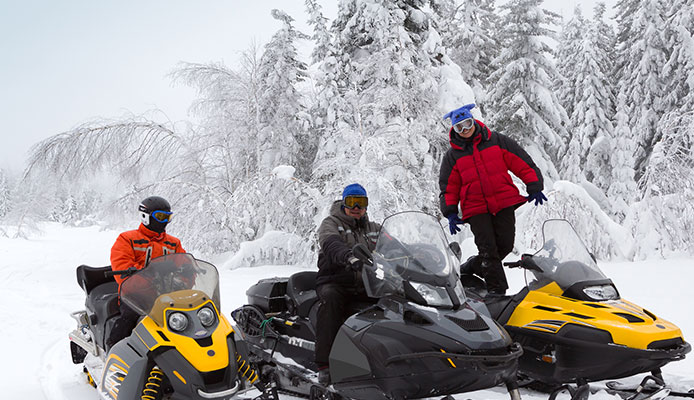
Size
It may seem trivial to worry about buying snowmobile boots that are the right size, but it is not. Despite being used to knowing what size shoes we wear without even having to think about it, it is essential to remember that the conditions you will use these boots in are very far from the ones that would let you get away with a simple pair of sneakers.
Cold, snow and humid environments make it strongly recommended to wear good, warm thick socks around your feet, and even two pairs sometimes! It is paramount that you consider this when you buy your boots, to avoid having to make compromises you won’t be able to fix once you’re out. Therefore, you should consider buying boots that are half a size or a size larger than the one you would normally buy to accommodate for the socks. If you can, bring a pair with you when you try them on for the first time. It pays off to feel a little too warm in the shop if it can avoid you great discomfort outside.
Fit
Once you’ve figured out which size is good for you, you need to make sure that the snowmobile boots fit you well. Remember that you will be wearing them for long hours on the days you will need them, so take your time to examine the reviews to get a good idea of what your feet will be going through when you put them in one of these. These boots can also feel stiff in the beginning before adapting to the shape of your foot, so try to take that into account as well.
The right balance is key, since boots that are too tight can prove excruciatingly uncomfortable and surely lead to painful blisters while limiting your freedom of movement, while boots that are too big give you that annoying feeling of dragging around something large and heavy at the end of your leg, proving to be an immediate buzzkill for most situations where movement is involved. Carefully reading the specifications for each model can help point you in the right direction, but it would be better to confirm your initial impressions with a hands-on test.
Insulation
When you look at the best snowmobiling boots sitting on shelves on a shop or browsing an online catalogue, it’s hard to judge how much insulation and warmth you need. Consider that apart from however cold that particular day out in the field is, you also have to factor in the wind-chill effect of riding a snowmobile as well as how much movement you plan to be doing.
Typically, if you’re a beginner you will spend most of the time sitting, and therefore you need more insulation to counter the effect of lack of movement. Most of the snowmobiling boots we reviewed have around 400-600 grams of insulation, which works pretty well for cold weather and a moderate level of activity. If you think you’ll be standing still most of the time, then we strongly recommend going higher than that, up to 800or 1000+ grams. If you want to be extra sure you won’t fell cold, think about bringing a pair of heated socks. The interior of the boots is designed to keep the warmth in so you can feel nice and cozy during your adventures.
Water-Resistance
All the insulation in the world will not help you if your boots are not well water resistant. We all know too well the effect water can have on how hot or warm you are, simply think of the feeling of walking around with a wet sock! It might not seem necessary if you think you’re only going to be sitting on your snowmobile, but having water resistant boots can make the difference between a great trip and a nightmare you just want to see the end of.
Most of the best snowmobile boots we have seen guarantee a good protection from water and moisture without particular issues. They usually do this in one of two ways, either with treated materials such as leather or rubber or by sewing a thin membrane inside the interior lining. Neoprene and rubber always keep the water out but can stifle your feet by not allowing them to breathe, while other materials such as leather will be more forgiving in this regard but need to be maintained in order to keep them working at their best, so know what you’re looking for when you’re judging what to buy.
Durability
Needless to say, this is a fundamental feature. During your outdoors excursions the last thing you want to worry about is getting injured, so you need durable snowmobiling boots that can sustain whatever unexpected stress they find themselves confronted with. Luckily for us, most manufacturers are aware of this and put special care in constructing tough and durable snowmobiling boots.
It’s hard to judge durability from an online review so make sure you pay close attention to the description of the materials these boots are made of. With modern materials and technology you can be reasonable assured that the best snowmobile boots will not let you down even in the most extreme situations, even if, as usual, it’s better if you don’t choose the cheapest version of them all, you might end up paying it in other ways after a while.
Moisture Wicking Features
Moisture wicking is the ability to move moisture away from the body and the fabric itself. This can help your body regulate its temperature even of you are sweating profusely and is a helpful feature in snowmobiling boots. It is unfortunately a quality that cotton doesn’t have, but the new materials that the boots we have shown you are made of do. It will help your feet stay dry even in extremely cold weather conditions. It is definitely a plus if your snowmobiling boots have this kind of ability to ensure they remain comfortable even if you wear them for several hours and let you focus solely on driving the snowmobile.
Lace System
Another thing that probably doesn’t come to mind when you shop for snowmobiling boots is that when you will have them on you will probably be wearing all sorts of other equipment on yourself. This probably includes thick snowmobile gloves<span style=”font-weight: 400;”> that, as you can imagine, make it very difficult to operate thin laces, that might be tightly knotted in intricate ways to ensure they don’t come apart.
Another option could be to take your gloves off and work the problem, but considering that this practically equates to putting your bare hands in snow you can easily see how this option is less than ideal. The solution? Simplicity. Choose boots that having simple and easy to access lace systems, or even Velcro straps if you really don’t want to bother, but keep this in mind when you’re making your decision, it could save you a lot of fussing and swearing later on.
Construction
Good construction leads to good durability, the benefits of which we have already discussed. Nowadays synthetic materials manage to combine lightness and toughness in a way that was not thought possible until a few years ago and the manufacturers of snowmobiling boots have been quick to use them to make their products better and stronger without making them too heavy.
Looking at the price should give you a good indication of the quality of the materials that have been used but the best way to judge is still to feel them for real and put them through their paces, so hop to your nearest shop or make sure that your online seller guarantees the possibility to return them if they don’t live up to your expectations.
Height
The correct height of you snowmobile boots is a very subjective matter and it something you can only be sure of when you feel them on your feet. Maybe try asking a friend if they have some you can try to get a better idea, or in any case read the snowmobile boots reviews very carefully. The point is finding a balance between adequate protection and mobility. A higher boot will make you feel warm and safe even if you’re wading through deep snow, especially so if it has a built in gaiter, but can prove to be cumbersome in some situations. Vice versa, a lower snowmobile boot will ensure great flexibility and versatility but force you to be careful as to how deep into the wetness your feet go. It’s up to you to decide then about the way you want to go, since only you know best what your specific needs and expectations are, but you should choose a boot that comes at least up over your ankle.
You might also like: Perfect Snowmobile Jackets
Weight
The weight of your snowmobiling boot is again a very subjective topic, one that also depends on your overall fitness and mobility. There is a great variety along the different models we have taken into consideration, with some boots weighing only 2 pounds and others getting as far as an incredible 5, and that’s just on one foot! Trying out your boots is crucial here, because it is the only way to efficiently evaluate whether they will help you out or feel like a burden. Maybe, if you’re feeling creative or you can’t manage to get your hands on a real pair of boots, you can try putting an equivalent weight on your feet or inside your shoes to get a feel of what it means moving around like that. A similar experiment that can already make you understand a great deal even without stepping out of your house.
Cuff Closure
The cuff closure is another one of those little details that can make the difference between an enjoyable day and a dreadful one. It’s a part of the boot you rarely examine closely, since the foot and sole are so much more impressive, but you forget how crucial it is that the cuff works well, fits snugly around your legs and most important of all stops snow or water from sliding into your feet. No amount of water resistance can save you then, and your feet won’t be dry for a long time despite all the warmth and technology that sits on the inside of the boots.
Don’t forget to give it a close inspection when you make your decision and thoroughly test it out before you take it in the field. We recommend paying close attention to the closing system as well. If you remember what we talked about when we considered laces, you will see how you need a simple and effective closing system that will let you avoid having to fidget around the closure when you feel the least like doing it and distract you from the rest of your outdoors adventure.
Temperature Rating
The temperature rating indicated the lowest temperature in which these boots can be comfortably worn. Most of the snowmobiling boots we have reviewed are rated to used down to temperatures of -40°C/-40°F, and that should cover the great majority of usage time without problems. It may seem excessive and uncalled for since it is rare to encounter such freezing temperatures, but you should never underestimate the damage cold can do to an outdoors experience, since it can make you think about little else if you have keep your teeth from rattling. Therefore, it is better to stay on the safe side and go with boots with a temperature rating such as the ones we have described, or even lower if you think the conditions will require it. Heated snowmobile boots can also be a good option.
FAQs
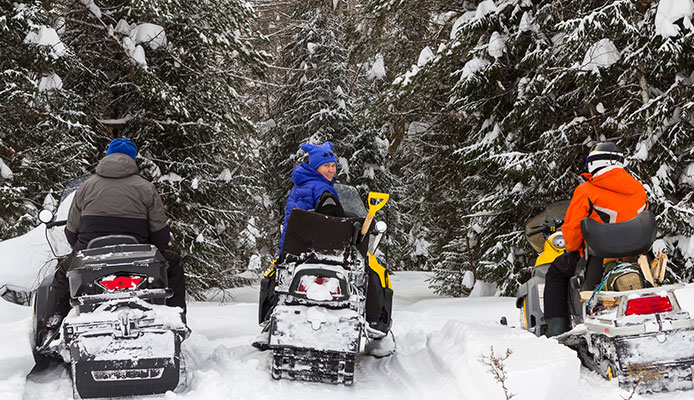
Q: Do I Need A Carb Boot For My Snowmobile?
You probably won’t find yourself in a situation where you need to use carb boots when you’re snowmobiling. These boots are more rigid than the ones we have described to you so they might ruin the experience by preventing you to move around as freely as you would like.
These boots definitely respect all the conditions we have described that make up a great snowmobiling boot, but you don’t absolutely need on I order to safely drive your machine. It is recommended that you use them only if you are not considering driving, as they can do more harm than good.
Q: Can I Wear My Snowboard Boots To Go Snowmobiling?
You can definitely try using snowboard boots when you’re going snowmobiling, but again these might not be the perfect fit for the job. They surely provide all the insulation and waterproof protection you may need, but their rigid structure is not recommended for an activity such as snowmobiling that requires you to constantly adjust your position on the seat while driving.
Some people might like the protective feel they provide, encasing your feet in a rigid box and supporting the ankles, but other might even get bruised because of the increased pressure. Keep in mind also that, as is always the case if you don’t use a tool specifically designed for the job, using snowboard boots while driving a snowmobile exposes you to the risk of damaging them.
Q: Do I Need A Metal Toe Guard?
You don’t absolutely need a metal toe guard for your snowmobiling boots, but it can be a plus. It provides extra protection for the front of your feet and makes you feel like you can take on anything you might find in your way, and you probably can! It’s almost as if you were wearing a piece of armor. The obvious drawback, of course, is the augmented weight that comes with it, that increases the heavy feel that some already weighty boots can have.
All things considered, it’s really up to you. Not having one is not a deal breaker and you can enjoy your time all the same, but if you feel the need of having that extra protection then by all means go for it!
Globo Surf Overview
If you take care of your feet on an outdoors adventure, your whole body will be grateful. This is especially true for winter sports and snowmobiling since they can put you through some of the harshest conditions you might imagine. Luckily, there are multiple options available for you to keep your feet warm, dry and protected.
The best snowmobiling boots you can get are one of those items you want to rely on without thinking, like your snowmobiling helmet for example. Users have confirmed that good boots can make up for another, less effective, piece of equipment but this does not work the other way around.
With this review choosing the best snowmobile boots for you should not be so hard now and you will be out on the snow enjoying yourself in no time!
More Snow Mobile Reviews:
- Snowmobile Handlebar Gauntlets
- Snowmobile Tunnel Bags
- Snowmobile Backpacks
- Snowmobile Tow Straps
- Snowmobile Goggles
- Snowmobile Ramps
- Snowmobile Pants & Bibs
- Snowmobile Covers
- Snowmobile Gloves
- More Boots Reviews:
- Ski Boots For Wide Feet
- Ski Boots For Beginners
- Ski Boots For Narrow Feet
- Cross Country Ski Boots
- Ski Boots For Kids
- Women Ski Boots
[RICH_REVIEWS_SHOW category=”snowmobile-boots”]
[RICH_REVIEWS_FORM category=”snowmobile-boots”]


